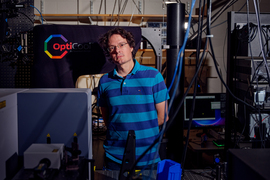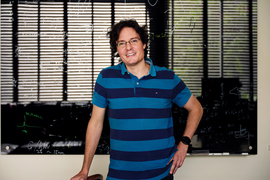Riccardo Comin says the best part of his job as a physics professor and exotic-materials researcher is when his students come into his office to tell him they have new, interesting data.
“It’s that moment of discovery, that moment of awe, of revelation of something that’s outside of anything you know,” says Comin, the Class of 1947 Career Development Associate Professor of Physics. “That’s what makes it all worthwhile.”
Intriguing data energizes Comin because it can potentially grant access to an unexplored world. His team has discovered materials with quantum and other exotic properties, which could find a range of applications, such as handling the world’s exploding quantities of data, more precise medical imaging, and vastly increased energy efficiency — to name just a few. For Comin, who has always been somewhat of an explorer, new discoveries satisfy a kind of intellectual wanderlust.
As a small child growing up in the city of Udine in northeast Italy, Comin loved geography and maps, even drawing his own of imaginary cities and countries. He traveled literally, too, touring Europe with his parents; his father was offered free train travel as a project manager on large projects for Italian railroads.
Comin also loved numbers from an early age, and by about eighth grade would go to the public library to delve into math textbooks about calculus and analytical geometry that were far beyond what he was being taught in school. Later, in high school, Comin enjoyed being challenged by a math and physics teacher who in class would ask him questions about extremely advanced concepts.
“My classmates were looking at me like I was an alien, but I had a lot of fun,” Comin says.
Unafraid to venture alone into more rarefied areas of study, Comin nonetheless sought community, and appreciated the rapport he had with his teacher.
“He gave me the kind of interaction I was looking for, because otherwise it would have been just me and my books,” Comin says. “He helped transform an isolated activity into a social one. He made me feel like I had a buddy.”
By the end of his undergraduate studies at the University of Trieste, Comin says he decided on experimental physics, to have “the opportunity to explore and observe physical phenomena.”
He visited a nearby research facility that houses the Elettra Synchrotron to look for a research position where he could work on his undergraduate thesis, and became interested in all of the materials science research being conducted there. Drawn to community as well as the research, he chose a group that was investigating how the atoms and molecules in a liquid can rearrange themselves to become a glass.
“This one group struck me. They seemed to really enjoy what they were doing, and they had fun outside of work and enjoyed the outdoors,” Comin says. “They seemed to be a nice group of people to be part of. I think I cared more about the social environment than the specific research topic.”
By the time Comin was finishing his master’s, also in Trieste, and wanted to get a PhD, his focus had turned to electrons inside a solid rather than the behavior of atoms and molecules. Having traveled “literally almost everywhere in Europe,” Comin says he wanted to experience a different research environment outside of Europe.
He told his academic advisor he wanted to go to North America and was connected with Andrea Damascelli, the Canada Research Chair in Electronic Structure of Quantum Materials at the University of British Columbia, who was working on high-temperature superconductors. Comin says he was fascinated by the behavior of the electrons in the materials Damascelli and his group were studying.
“It’s almost like a quantum choreography, particles that dance together” rather than moving in many different directions, Comin says.
Comin’s subsequent postdoctoral work at the University of Toronto, focusing on optoelectronic materials — which can interact with photons and electrical energy — ignited his passion for connecting a material’s properties to its functionality and bridging the gap between fundamental physics and real-world applications.
Since coming to MIT in 2016, Comin has continued to delight in the behavior of electrons. He and Joe Checkelsky, associate professor of physics, had a breakthrough with a new class of materials in which electrons, very atypically, are nearly stationary.
Such materials could be used to explore zero energy loss, such as from power lines, and new approaches to quantum computing.
“It’s a very peculiar state of matter,” says Comin. “Normally, electrons are just zapping around. If you put an electron in a crystalline environment, what that electron will want to do is hop around, explore its neighbors, and basically be everywhere at the same time.”
The more sedentary electrons occurred in materials where a structure of interlaced triangles and hexagons tended to trap the electrons on the hexagons and, because the electrons all have the same energy, they create what’s called an electronic flat band, referring to the pattern that is created when they are measured. Their existence was predicted theoretically, but they had not been observed.
Comin says he and his colleagues made educated guesses on where to find flat bands, but they were elusive. After three years of research, however, they had a breakthrough.
“We put a sample material in an experimental chamber, we aligned the sample to do the experiment and started the measurement and, literally, five to 10 minutes later, we saw this beautiful flat band on the screen,” Comin says. “It was so clear, like this thing was basically screaming, How could you not find me before?
“That started off a whole area of research that is growing and growing — and a new direction in our field.”
Comin’s later research into certain two-dimensional materials with the thickness of single atoms and an internal structural feature of chirality, or right-handedness or left-handedness similar to how a spiral has a twist in one direction or the other, has yielded another new realm to explore.
By controlling the chirality, “there are interesting prospects of realizing a whole new class of devices” that could store information in a way that’s more robust and much more energy-efficient than current methods, says Comin, who is affiliated with MIT’s Materials Research Laboratory. Such devices would be especially valuable as the amount of data available generally and technologies like artificial intelligence grow exponentially.
While investigating these previously unknown properties of certain materials, Comin is characteristically adventurous in his pursuit.
“I embrace the randomness that nature throws at you,” he says. “It appears random, but there could be something behind it, so we try variations, switch things around, see what nature serves you. Much of what we discover is due to luck — and the rest boils down to a mix of knowledge and intuition to recognize when we’re seeing something new, something that’s worth exploring.”












